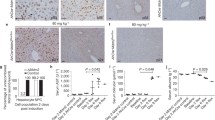Abstract
Many chronic liver diseases are life-threatening. When the liver loses the ability to repair itself the only treatment currently available is liver transplant. However, there are not enough donors to treat all the patients. This requires the search of alternative therapies utilizing stem and progenitor cells for treatment of these patients and restoration of their normal liver function.
Hepatic progenitor cells can be isolated from livers at different developmental stages including adult liver. In the adult rat liver, there is clear evidence that progenitor cells (also called “oval cells”) derive from precursors in the canals of Herring that are capable to differentiate into hepatocytes and bile duct cells. In experimental models, hepatic progenitor cells can be isolated and propagated in vitro and used for restoration of the diseased liver. The first step in utilization of progenitor cells is their identification in the liver, isolation of purified progenitor cell fractions, which are subsequently transplanted in the diseased liver for evaluation of liver repopulation by transplanted cells, and evaluation their potentials for clinical application.
The present protocol describes the isolation of non-parenchymal cells (NPCs) from wt DPPIV+ F344 rats, followed by purification of “oval cells”, immunohistochemical staining techniques to characterize these cells, their transplantation into retrorsine-treated mutant DPPIV− rats, as well as the enzyme histochemical staining for DPPIV to detect transplanted cells in the host liver.
Access this chapter
Tax calculation will be finalised at checkout
Purchases are for personal use only
Similar content being viewed by others
References
Wilson JW, Leduc EH (1958) Roles of cholangioles in restoration of the liver of the mouse after dietary injury. J Pathol Bacteriol 76:441–449
Farber E (1956) Similarities in the sequence of early histological changes induced in the liver of the rat by ethionine, 2-acetylamino-fluorene, and 3′-methyl-4-dimethylaminoazobenzene. Cancer Res 16:142–148
Lemire JM, Shiojiri N, Fausto N (1991) Oval cell proliferation and the origin of small hepatocytes in liver injury induced by D-galactosamine. Am J Pathol 139:535–552
Sells MA, Katyal SL, Shinozuka H et al (1981) Isolation of oval cells and transitional cells from the livers of rats fed the carcinogen DL-ethionine. J Natl Cancer Inst 66:355–362
Oertel M, Shafritz DA (2008) Stem cells, cell transplantation and liver repopulation. Biochim Biophys Acta 1782:61–74
Yovchev MI, Grozdanov PN, Joseph B et al (2007) Novel hepatic progenitor cell surface markers in the adult rat liver. Hepatology 45:139–149
Yaswen P, Nancy T, Hayner NT, Fausto N (1984) Isolation of oval cells by centrifugal elutriation and comparison with other cell types purified from normal and preneoplastic livers. Cancer Res 44:324–331
Dabeva MD, Hwang S-G, Vasa SRG et al (1997) Differentiation of pancreatic epithelial progenitor cells into hepatocytes following transplantation into rat liver. Proc Natl Acad Sci USA 94:7356–7361
Yovchev MI, Grozdanov PN, Zhou H et al (2008) Identification of adult hepatic progenitor cells capable of repopulating injured rat liver. Hepatology 47:636–647
Yovchev MI, Zhang J, Neufeld DS et al (2009) Thymus cell antigen-1-expressing cells in the oval cell compartment. Hepatology 50:601–611
Oertel M, Menthena A, Chen Y-Q et al (2007) Comparison of hepatic properties and transplantation of Thy1+ and Thy-1− cells isolated from ED14 rat fetal liver. Hepatology 46:1236–1245
Oertel M, Menthena A, Chen Y-Q et al (2008) Purification of fetal liver stem/progenitor cells containing all the repopulation potential for normal adult rat liver. Gastroenterology 134:823–832
Thompson NL, Hixson DC, Callanan H et al (1991) A Fischer rat substrain deficient in dipeptidyl peptidase IV activity makes normal steady-state RNA levels and an altered protein. Use as a liver-cell transplantation model. Biochem J 273:497–502
Rajvanshi PA, Kerr A, Bhargava KK et al (1996) Studies of liver repopulation using the dipeptidyl peptidase IV deficient rat and other rodent recipients: cell size and structure relationships regulate capacity for increased transplanted hepatocytes mass in the liver lobule. Hepatology 23:482–496
Lojda Z (1979) Studies on dipeptidyl(amino)peptidase IV (glycyl-proline naphthylamidase). II. Blood vessels. Histochemistry 59:153–166
Oertel M (2011) Fetal liver cell transplantation as a potential alternative to whole liver transplantation? J Gastroenterol 46:953–965
Laconi E, Oren R, Mukhopadhay D et al (1998) Long-term, near total liver replacement by transplantation of isolated hepatocytes. Am J Pathol 153:319–329
Neufeld DS (1997) Isolation of rat liver hepatocytes. Methods Mol Biol 75:145–151
Author information
Authors and Affiliations
Corresponding author
Editor information
Editors and Affiliations
Rights and permissions
Copyright information
© 2013 Springer Science+Business Media, LLC
About this protocol
Cite this protocol
Yovchev, M.I., Dabeva, M.D., Oertel, M. (2013). Isolation, Characterization, and Transplantation of Adult Liver Progenitor Cells. In: Turksen, K. (eds) Stem Cells and Aging. Methods in Molecular Biology, vol 976. Humana Press, Totowa, NJ. https://doi.org/10.1007/978-1-62703-317-6_4
Download citation
DOI: https://doi.org/10.1007/978-1-62703-317-6_4
Published:
Publisher Name: Humana Press, Totowa, NJ
Print ISBN: 978-1-62703-316-9
Online ISBN: 978-1-62703-317-6
eBook Packages: Springer Protocols




